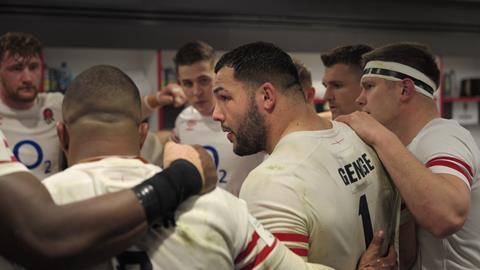Luke Boyle, chief growth officer at UIC Digital, gives his recommendations to the likes of the BBC & ITV

“If you’re picking for the World Cup Final, you’re picking experience with youth. Everything is better off having that balance and that mix.” - Prince William, Patron of the Welsh Rugby Union (WRU).
Prince William’s lifelong affiliation with rugby has provided him with a keen eye for the ingredients behind on-field success. But his advocacy for a blended, balanced approach should strike a chord with those responsible for bringing coverage to the small screen.
BBC and ITV have been passing the Six Nations broadcasting ball between one another since signing a deal in 2015. However, their traditional format - featuring match coverage sandwiched between run-of-the-mill punditry - has started to drift wide of the posts.
ITV’s coverage of England versus Scotland amassed 8.4m viewers in 2021; the corresponding fixture last year had only 4.5m. This is part of a macro trend, with television bearing the brunt of consumers’ shifting viewing behaviours. Broadcast television’s weekly audience reach suffered its steepest decline in 2023 since records began.
Broadcasters can’t afford to keep dropping the ball. The government’s refusal to give the Six Nations ‘Crown Jewels’ status has seen the threat from pay-television and streaming platforms intensify. However, this doesn’t mean they have to start from square one.
Netflix’s sporting playbook illustrates how pairing exciting on-field action with innovative off-field features can secure broadcasters a much-needed Grand Slam.
Taking stock of your opponent
Netflix didn’t top the sports coverage world rankings overnight.
The streaming platform got the ball rolling when it launched Last Chance U in 2016. The docuseries provided an unbridled, behind-the-curtain experience that viewers craved. And its success inspired Netflix to stay faithful to the format, with Drive to Survive and The Last Dance following in its footsteps.
Six Nations: Full Contact is the latest instalment in Netflix’s sporting conveyor belt. The rugby-oriented series, released days before this year’s tournament kicked-off, proved an instant slam dunk. It took Drive to Survive four seasons to match its rugby equivalent’s ratings.
The series featured a host of riveting (and painful) highlights, with France’s 53-10 demolition of England and Scotland’s 35-7 dismantling of Wales to name but two. However, on-field drama alone doesn’t capture viewers’ hearts, minds and eyes - particularly when it comes to younger audiences.
Deloitte’s research found that more than 90% of Gen Z and millennials use social media to consume sporting content. Only 58% say that live matches are their favourite type of sporting content.
At-home viewing experiences extend beyond the 80 minutes on the pitch. The Six Nations’ social team quickly cottoned on to this. Its post of Finn Russell’s tongue-in-cheek comparison to Lionel Messi on X went viral. The clip, lifted from Netflix’s series, garnered more than 400,000 views.
Yes, the goalposts for consumers’ viewing behaviours have shifted. But broadcasters shouldn’t accept their place in the sin-bin lying down. Bringing in technical support from the sidelines can be the catalyst for a second-half resurgence.
Levelling the playing field
Watching sports is a social experience; an emotional rollercoaster encompassing exhilarating highs and heart-breaking lows.
This environment doesn’t have to be confined solely to the stands. BT Sport’s Watch Together feature, released during the pandemic, allowed users to watch their favourite teams with their friends and family from the comfort of their homes. And this is only the tip of the interactivity iceberg.
Broadcasters have to recognise that no fan is the same. Adhering to a ‘one-size-fits-all’ coverage strategy will quickly leave viewers heading for the gate. Personalisation of services is absolutely key in the modern broadcast environment, what your grandparents want from the interaction is totally different to the short attention span of a ten year old, who is just as excited, but must have that attention gripped.
Technology can be the great equaliser, enabling broadcasters to consistently deliver unique experiences. Take our work with UEFA, for example. When we started the collaboration back in 2010, conversations were very different. Today’s tech was in its infancy - it was a time when Apple launched its first iPad, when Uber and Netflix were still trialling their apps and Instagram had only just been born. Our relationship has since blossomed, taking them through various technical developments to keep UEFA at the forefront of the digital landscape - now not just as a modern association but a broadcaster in its own right.
Fast forward to today, viewers are operating across multiple screens. Nielsen’s research found that more than half of sports fans are checking live stats whilst watching. Embracing this trend and using gamification tactics to post interactive graphics - such as polls, quizzes and statistics - provides an opportunity to drive engagement. Gamification strategies can improve consumer engagement by 47%.
Technology can also open the door to connecting with new age groups. Nickelodeon’s Super Bowl coverage leaned on Spongebob Squarepants and Patrick Star to gain traction with younger viewers. Prior to that, Disney+’s Toy Story-themed NFL match was the streamer’s largest live event. Audience share for ages 2-11 and 12-17 rose 4% and 5% respectively. Small gains - but ones that illustrate a changing of the guard.
Finding a match winner
The Six Nations may be three rounds deep, but that doesn’t mean broadcasters can be complacent. Declining viewership should serve as a wake-up call, emphasising the need for greater innovation. And in Netflix and other streaming platforms, broadcasters have the ideal coaches to learn from.
Sports coverage shouldn’t be a one-dimensional strategy. Championship winning teams feature a blend of exciting attack and ironclad defence. It’s the broadcasters that integrate new technical features without hindering their user experience that will go the length of the field.

Luke Boyle is chief growth officer at UIC Digital.







No comments yet